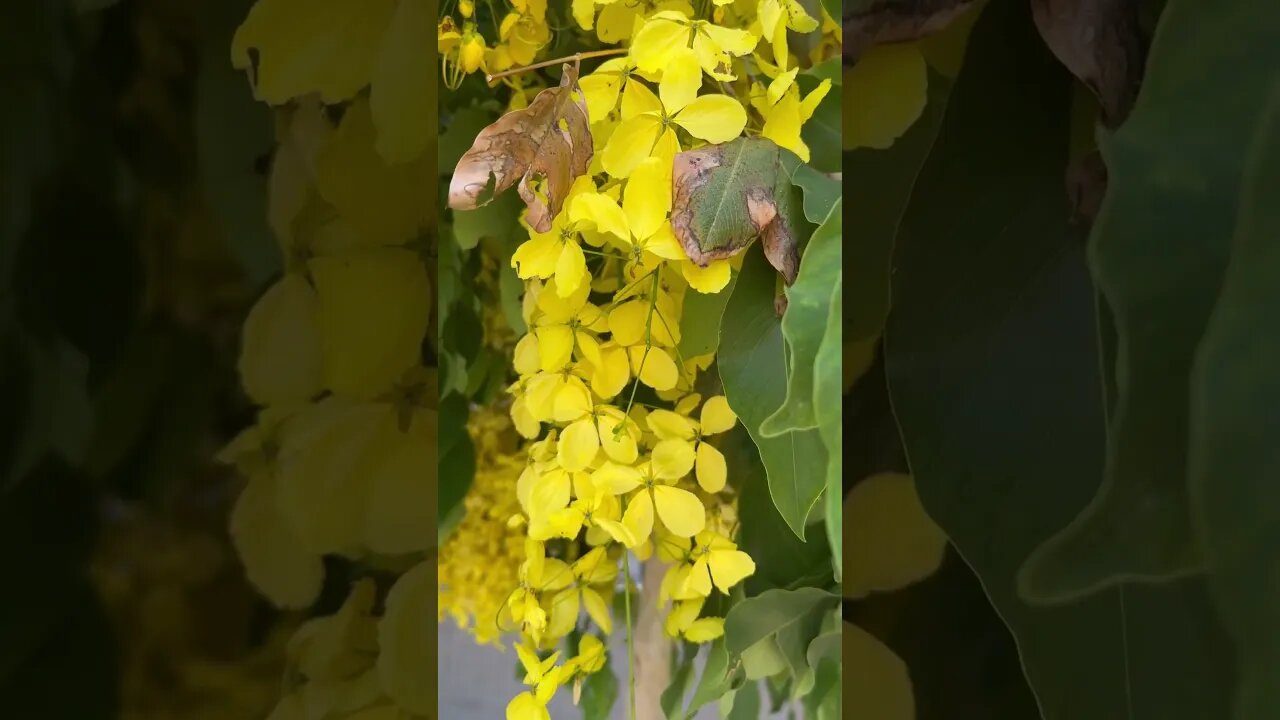Premium Only Content

Everything about the Golden Shower Tree
#Goldenshowertree #Goldenshowerflowers #deciduoustre #floweringtree
The Golden Shower Tree, scientifically known as Cassia fistula, is a flowering tree native to the Indian subcontinent and other parts of Southeast Asia. It is widely cultivated for its beautiful yellow flowers and ornamental value.
Here's everything you need to know about the Golden Shower Tree:
Appearance: The Golden Shower Tree is a medium-sized deciduous tree that can reach heights of up to 10-20 meters (30-60 feet) tall. It has a wide, spreading crown and a relatively short trunk. The leaves are pinnate, with 8-12 pairs of leaflets that are green and oval-shaped. The tree gets its name from the abundant clusters of vibrant yellow flowers that hang from the branches. The flowers have a distinct shape with four petals and a central boss of stamens.
Flowering: The Golden Shower Tree is known for its spectacular display of flowers. The flowering season typically occurs during the spring or early summer, although it may vary depending on the climate. The tree produces large pendulous racemes that can be up to 50 centimeters (20 inches) long, containing numerous flowers. Each flower is around 5-7 centimeters (2-3 inches) in diameter and has a sweet fragrance.
Cultural Significance: The Golden Shower Tree holds cultural significance in various countries. In India, it is the national flower of Kerala and the state flower of Tamil Nadu. The tree is also associated with festivals and religious ceremonies. In Thailand, the Golden Shower Tree is known as "Ratchaphruek" and is the national flower.
Medicinal Uses: Various parts of the Golden Shower Tree, including the bark, leaves, flowers, and fruit, have been traditionally used in Ayurvedic and traditional medicine systems for their therapeutic properties. The tree is believed to have laxative, antibacterial, antifungal, and antiviral properties. It has been used to treat constipation, skin diseases, digestive disorders, and respiratory ailments.
Wildlife and Ecology: The Golden Shower Tree provides an important food source for birds, bees, and butterflies. The flowers attract pollinators, while the ripe seed pods are consumed by birds and small mammals. The tree is also known to fix nitrogen in the soil, making it beneficial for the surrounding ecosystem.
Ornamental Use: Due to its stunning flowers, the Golden Shower Tree is widely planted as an ornamental tree in parks, gardens, and along streets. It adds a vibrant touch to the landscape and is often used as a focal point in landscaping designs.
Growing Requirements: The Golden Shower Tree thrives in tropical and subtropical climates. It prefers full sun exposure and well-drained soil. Once established, it can tolerate dry conditions but benefits from regular watering. It is a relatively fast-growing tree and can be propagated from seeds or cuttings.
Conservation Status: The Golden Shower Tree is not currently considered a threatened species. However, habitat destruction and illegal harvesting for its timber and medicinal use can pose threats to its populations in some regions.
Remember, while the Golden Shower Tree is admired for its beauty and cultural significance, it is essential to respect local regulations and guidelines regarding the cultivation and conservation of this species.
-
 1:32:31
1:32:31
Redacted News
3 hours agoEMERGENCY BROADCAST! IS THIS WORLD WAR 3? U.S. PREPS FOR MASSIVE RETALIATION, KINGS DAY FALSE FLAGS
102K303 -
 1:05:15
1:05:15
vivafrei
6 hours agoDemocrats Latest Political Stunt! Gavin Newsom's Premature Victory Lap! Rick Wilson is a POS & MORE!
60.7K43 -
 2:01:14
2:01:14
Pop Culture Crisis
4 hours agoBonnie Blue BANNED, Tradwife Nara Smith BULLIED, Actress FAKES Brain Cancer?! | Ep. 856
27.5K2 -
 LIVE
LIVE
Akademiks
6 hours agoDiddy Trial Day 23: Kanye West Shows up to Support DIDDY n CONFRONT JANE DOE Day 5/30
1,681 watching -
 11:35
11:35
Silver Dragons
3 hours agoGold Price SOARING & Fort Knox Gold Audit IMPENDING
11.6K2 -
 59:56
59:56
Crypto Power Hour
11 hours ago $0.68 earnedCrypto Trading With GROK
26.4K3 -
 1:14:30
1:14:30
Jeff Ahern
4 hours ago $0.91 earnedFriday Freak Out with Jeff Ahern
23.6K5 -
 15:17
15:17
Russell Brand
4 hours agoIt's about time...
61.5K98 -
 4:46:26
4:46:26
StoneMountain64
5 hours agoPUBG is truly INCREDIBLE
61.7K4 -
 LIVE
LIVE
Spartan
4 hours agoPro Halo Player | Scrims vs FaZe @ 3 EST then Ranked and/or SWTOR
23 watching